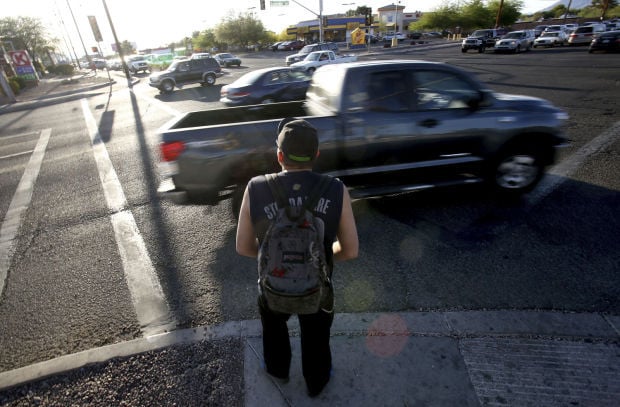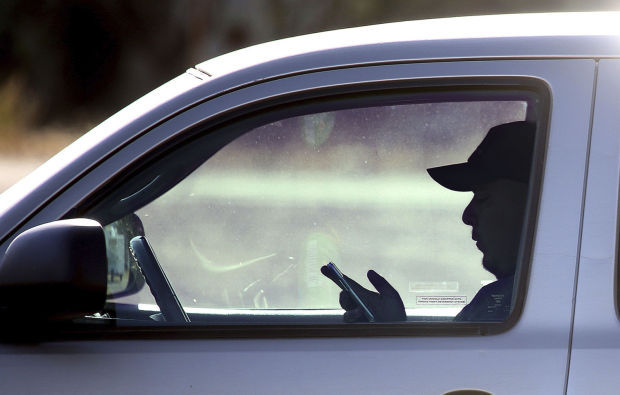It happened in an instant.
As the driver made a right turn out of a store parking lot, looking to her left to watch for traffic, she felt as if she hit a curb. It wasn’t until she looked at her rearview mirror and saw a man lying in the road behind her that she realized she had hit a person.
She stopped her car and rushed to help the man, who was severely injured and trying to get back up.
“He was leaning up against my legs, because I don’t think he wanted to lay down,” she said. “I remember the weight of just holding him.”
The driver, whom the Star is not identifying because she wasn’t charged with a crime, didn’t see the man. A witness told police he ran into traffic.
One week later, the man died in a hospital, making him one of 25 pedestrians hit and killed last year, the highest number of pedestrian fatalities Tucson has seen in eight years.
Arizona is sixth among the states for the highest pedestrian fatality rates, statistics from a 2014 Alliance for Biking and Walking report show.
Of the 2013 crash victims:
- At least 11 tested positive for drugs or alcohol.
- 15 were hit at night, nearly half in unlit areas.
- At least 16 were not in a crosswalk.
Of the drivers:
- Five were charged with a crime or traffic offense.
- At least two are being sued for wrongful death.
- One showed signs of impairment.
- Nearly all of them crashed within a block or two of a major intersection.
Distraction — both by pedestrians and drivers — is a common denominator in the uptick in fatal crashes, said Dave Fernandez, sergeant for the Tucson Police Department traffic enforcement division.
But a Star analysis shows that police reports of the incidents were often unclear about whether drivers were distracted.
Despite a city ban on texting while driving, unless the officer sees the driver on the phone, drivers are not legally required to show their phones to police. If the driver doesn’t want to hand over a phone, an officer would need to get a warrant. And police rarely have time to get a warrant for phone logs, Fernandez said.
In none of the fatal crashes last year did police note that they’d asked for a warrant to search a driver’s phone, the Star analysis shows. In one case, in which a woman hit a man and two children in a crosswalk in midtown, police found a cellphone on her rear driver-side floor during their investigation.
Pedestrians are distracted, too.
Fernandez often sees people walking while listening to music or texting, unable to hear or see what is going on around them.
About half of the police reports the Star examined mentioned that the pedestrian was distracted before the crash. In one fatal crash in January 2013, witnesses told police that the pedestrian who was killed was wearing earbuds and looking down at a handheld device when he walked into the road against a red light.
CAMPAIGNING
FOR AWARENESS
Although Tucson has had a task force for bicycle safety for more than 20 years, leaders only recently turned their attention to pedestrian issues.
Last year, the City Council established a new pedestrian advisory committee.
Still in its beginning stages, the committee is brainstorming ideas to make the city a safer and more walkable place for pedestrians.
The group is planning an awareness campaign — featuring a famous furry cat — to attract attention to the growing problem of pedestrian crashes.
The task force wants to send Wilbur the Wildcat to test drivers to see if they yield for pedestrians.
With a safety assist from a police officer, the University of Arizona mascot will attempt to cross a busy street in a crosswalk. An officer will monitor drivers and hand out warnings to those who don’t yield to the 6-foot-tall feline.
The idea is that if a driver cannot see a popular mascot donning a fuzzy suit and huge hat, he or she likely would never see a child in the street, said Ann Chanecka, the city’s bike and pedestrian coordinator.
In addition to the task force’s efforts, the nonprofit Living Streets Alliance is pushing for new policies to benefit walkers.
Residents often request shady trees, lower speed limits and improved sidewalks in their neighborhoods, but “those sorts of improvements very rarely happen in our community,” said Emily Yetman, the organization’s executive director. Neighborhood improvements come only after officials study the need, consider funding and often experience long delays.
Advocating for pedestrians can be difficult because — unlike more organized groups like cyclists — people often don’t identify themselves as pedestrians, she said. But whether a person is crossing a major roadway to the bus stop or crossing a parking lot while running errands, everyone is a pedestrian at some point during the day, she said.
Motorists and pedestrians share the responsibility of staying safe, Chanecka said.
Motorists need to concentrate on their driving and do all they can to pay attention to others on and near the road with them, she said.
“But then at the same time, pedestrians should try to be as aware as they can be and as visible,” she said. “Even if you’re in a marked crosswalk or unmarked crosswalk, and you’re doing everything you should be and a motorist doesn’t see you, you’re still the one vulnerable and will get hurt.”
A SYSTEMATIC APPROACH
Infrastructure is part of the solution, but deciding where to make improvements is difficult, Pima County transportation engineers said.
Problematic areas are typically higher density, such as near large apartment complexes, and lower socioeconomic areas where fewer people drive cars, said Robert Lane, traffic safety engineer for the Pima County Department of Transportation.
When a neighborhood association, city department or individual asks the Transportation Department to study a particular location, a study group analyzes the area and traffic engineers review 10 years of pedestrian crash data for the site. It can take years to systematically assess the problem, design a solution and find funding, said Bill Strickler, civil engineering manager for the Pima County Department of Transportation.
It takes years, too, for those involved in the crashes to grieve.
More than a year after hitting and killing a man, the driver still cannot talk about the accident without fighting back tears and puffing on an e-cigarette to calm her nerves.
Memories of the gruesome scene haunt her. Every time she drives over a speed bump or a pothole, anxiety grips her. She panics and checks her mirrors, terrified that she has hit someone.
Although no one was deemed at fault for the accident and she wasn’t cited for a traffic offense, she lives with guilt every day.
“I’ll forever be sorry,” she said.





